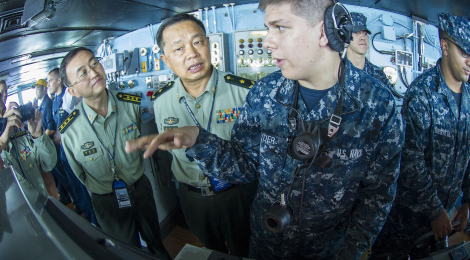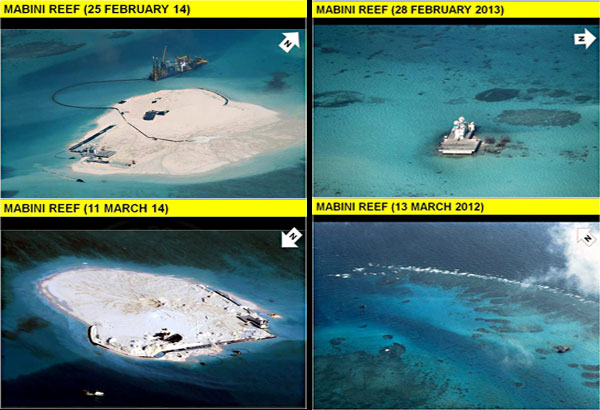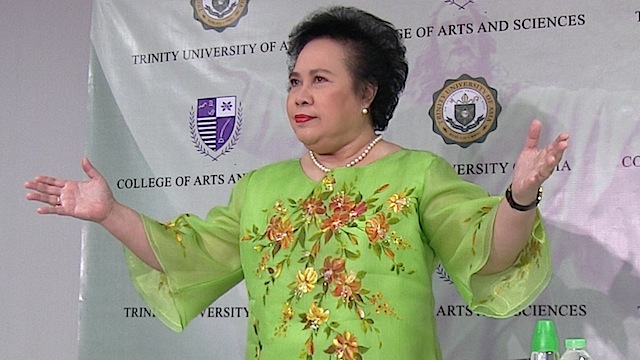From War on the Rocks (Nov 25):
The South China Sea: Navigating the Most Dangerous Place in the World (by Michael McDevitt)

When people ponder where the next major conflict might erupt, they often look to the South China Sea – the scene of the potentially most explosive, intractable, overlapping sovereignty claims in the world. What can the United States do to find a peaceful solution to tensions between China, the Philippines and Vietnam, and indirectly between Beijing and Washington?
These problems in the South China Sea are not new; the
first U.S. policy statement regarding South China Sea disputes was made in 1995. Today’s policy is virtually identical, i.e., a peaceful, non-coercive diplomatic resolution that preserves regional stability and freedom of navigation in one of the world’s most heavily travelled seaways. What is different is that after almost a decade and a half of relative tranquility, the South China Sea has emerged as a cockpit of contention that raises the potential for conflict and introduces instability in Southeast Asia. The United States could become directly involved because the Philippines, one of the contending claimants to land features in the South China Sea, is a U.S. treaty ally.
In the South China Sea there are approximately 180 features above water at high tide. These rocks, shoals, sandbanks, reefs, and cays, plus unnamed shoals and submerged features are distributed among four geographically different areas of that sea. These features are claimed in whole or in part by China, Taiwan, Vietnam, the Philippines, Malaysia, and Brunei. China and Taiwan (the Republic of China) claim all of the land features in the South China Sea. A bedrock principle of U.S. policy is that Washington takes no position on the legal merits of these respective claims.
Why Should Anyone Care who Owns largely Uninhabitable Islands and Rocks?
A very small number of the land features have strategic value for the claimants because they have, or could have, runways long enough to accommodate tactical jet aircraft and are adjacent to some of the world’s most heavily travelled commercial shipping routes. In short, gaining sovereignty provides a foothold that could enable a country to interfere with trade to or from China and the rest of Northeast Asia. This is highly unlikely, but nonetheless, the strategic location of the South China Sea islands has been on the minds of strategists since the end of the First World War.
Beyond this, sovereignty carries with it certain rights to the resources of the surrounding waters—either 12-mile territorial waters, or, if the feature is deemed an island, a 200-nautical mile Exclusive Economic Zone (EEZ). These maritime entitlements associated with features above-water at high tide offer access to fish, hydrocarbons, and minerals on or beneath the ocean floor. Finally, nationalism is very important (especially in China) because pressure to uphold “our sovereign territory” limits the options of claimants.
China in the South China Sea
China already has control of all the disputed land features in the northern portion of the South China Sea. It has controlled the Paracel Islands since 1974 when it forcibly ejected South Vietnamese forces that occupied about half of the islands, and, despite Vietnam’s continuing sovereignty claims, is unlikely to ever leave. China effectively resolved the dispute with the Philippines over Scarborough Shoal in 2012 when it secured control over the feature Again, despite protests from Manila, China is unlikely to relinquish it. This means that the Spratly Islands are the only remaining disputed South China Sea feature not completely under the physical control of China.
China’s approach in the South China Sea is best described as “peacefully coercive.” It carefully avoids direct involvement of its navy, and instead relies upon its Coast Guard and fishing fleet to pursue what is often characterized as a
“salami slice” strategy, in taking small, incremental steps that are not likely to provoke a military response from any of the other claimants, but over time gradually change the status quo regarding disputed claims in its favor.
This knotty sovereignty issue is greatly exacerbated by the “nine-dash line” that appears on all Chinese maps of the South China Sea. It incorporates about 80 percent of the South China Sea and cuts through the EEZ of the other littoral states. Over the past several years Chinese actions strongly suggest the line is much more than a cartographical annotation depicting China’s claims to the land features—it is an attempt to claim China has “historic rights” to a significant portion of the fish and hydrocarbon resources that, under the Law of the Sea Treaty (UNCLOS), legitimately belong to the coastal states. This apparent attempt to rewrite commonly accepted international law to include the concept of “historic rights” has resulted in a number of incidents with its neighbors.
What are U.S. interests the South China Sea?
Starting in summer 2010, the Obama administration clearly signaled that the United States considers establishing rule-based stability in the South China Sea to be an important U.S. national priority. The administration did this through a combination of diplomacy and enhanced military engagement with the South China Sea littoral states of Vietnam, the Philippines, Malaysia, and Indonesia.
The United States also has an abiding interest in “freedom of navigation” in the South China Sea. Washington believes that UNCLOS permits any nation to exercise “high seas freedoms” in the EEZ of any coastal state. These freedoms include,
inter alia, peaceful military activities including surveillance. China disagrees. It claims that these are not “peaceful” activities. This disagreement has resulted in two serious incidents: the 2001 mid-air collision between a U.S. Navy surveillance aircraft (EP-3) and an intercepting Chinese navy fighter, and the 2009 episode in which Chinese fishermen and paramilitary ships harassed USNS
Impeccable. More recently, a dangerously close intercept of a U.S. Navy P-8 maritime patrol aircraft created another diplomatic dustup.
The U.S. defense treaty with the Philippines is an important obligation. If China were to attack a Philippine naval or coast guard vessel, shoot down a Philippine military aircraft, or kill or wound members of the Philippine armed forces,
treaty language related to attacks on “its [the Philippines’] armed forces, public vessels or aircraft in the Pacific” suggests that the treaty would apply.
Finally, China is very important to the resolution of other critical issues that matter to Washington, such as ending the Iranian and North Korean nuclear programs; addressing climate change; maintaining peace in the Taiwan Strait and East China Sea; and promoting trade, investment, and economic growth. This mix of significant interests forms the broader context for U.S.-China relations, and makes it clear that the
South China Sea should not become the central element in the overall U.S.-China relationship.
Existing U.S. policy toward the South China Sea
Based on public statements and Congressional testimony from serving U.S. officials, U.S. policy consists of the following key elements:
- No use of force or coercion by any of the claimants to resolve sovereignty disputes or change the status quo of disputed South China Sea features.
- Freedom of navigation, which includes unimpeded lawful navigation for commercial, private, and military vessels and aircraft. Coastal states must respect the UNCLOS language that all “high seas freedoms,” which include peaceful military operations, are permissible within coastal states’ EEZs.
- All maritime entitlements to any of the waters of the South China Sea must be based on international law and must be derived from land features in the South China Sea. China’s nine-dash line does not meet these criteria.
- The United States takes no position on the relative merits of competing sovereignty claims. It does not favor one country’s claim over another’s.
- An effective Code of Conduct that would promote a rules-based framework for managing and regulating the behavior of relevant countries in the South China Sea is essential.
This policy is sensible, relatively comprehensive, and proportionate to the U.S. interests involved. The administration’s public rhetoric has, over time, become far more specific and less “diplomatic”; it now specifically calls China’s actions destabilizing and bullying. Policy has also become more specific in its commentary regarding the “rules.” It has addressed the most destabilizing aspect of the South China Sea disputes: the nine-dash line. But despite being judged sensible and proportionate, the Obama administration’s policy has been criticized from both the right and the left for not being “tough” enough with China.
The simple reason for the criticism is that China has essentially ignored U.S. exhortations to follow the rules, to stop pushing other claimants around, and to seek third-party arbitration to resolve claims. Beijing apparently believes that national interest trumps adherence to international law.
That said how should U.S. policy proceed?
To supplement extant policy, overarching policy guidelines should include the following principles:
- The South China Sea is not the central strategic element in the overall U.S.-China relationship.
- The South China Sea is an issue to be managed; a permanent solution is not likely in the near term.
- There is no one preferred format for negotiated outcomes. Bilateral negotiations should not be dismissed or portrayed as less desirable. The reality is that because of overlapping claims, solutions that are negotiated directly by the claimants are inevitable.
- Policy should not be overwhelmingly anti-Chinese. The United States should criticize Chinese behavior along with the behavior of American friends and allies when warranted, but be mindful that China may have the best legal claim to all the land features.
- The U.S. government should remain sensitive to the efforts of littoral states to involve the United States more deeply in supporting their claims in order to balance against China.
- Washington should not announce policies that engage credibility in a way it is not prepared to back up. In short, don’t bluff.
The United States should issue a comprehensive white paper, or a series of white papers, on the various aspects of international law that pertain to the South China Sea in order to reinforce the existing U.S. policy emphasis on international law as the basis for rules-based stability. Because the focus on international law has been such a centerpiece of U.S. policy, these authoritative documents should be signed by the secretary of state and given appropriate publicity.
In January 2013, the Philippine government effectively took China to court by requesting an arbitral panel determine if the Chinese nine-dash line and claims to submerged features on the Philippine continental shelf were permitted by UNCLOS. The arbitral panel has to decide whether it itself has jurisdiction or not. The State Department should consider issuing a statement in strong support of a favorable ruling on jurisdiction so the Philippines can have “its day in court”.
U.S. policymakers should explore with ASEAN and China the possibility of establishing a Joint Development Area (JDA) in the Spratlys aimed at the exploitation of hydrocarbons. The goal would be to find a way to allow states to share these resources without prejudicing their position on final maritime boundaries. ASEAN normally does not welcome outside interference in what it judges are ASEAN diplomatic equities, but since the Code of Conduct process is stalled by Chinese foot-dragging, U.S. policymakers should explore whether ASEAN would welcome any American involvement aimed at moving the Code of Conduct process to conclusion.
To help these littoral states help themselves, Washington should be responsive to requests from small littoral states in the region that want assistance in improving their maritime policing and security capabilities. This would also include a commitment to a long-term, dedicated effort to improve the maritime capabilities of the Armed Forces of the Philippine’s. A
mutually agreed upon AFP “minimum credible deterrent” plan deserves strong U.S. support. Washington should not, however, expand the scope of the Mutual Defense Treaty to cover the contested Philippine claims in the Spratlys.
In terms of planned U.S. military posture improvements associated with the rebalance, Washington should ensure they are portrayed as symbols of reassurance and a stability-inducing presence rather than attempts to directly confront China. The emphasis should be that the objective military aspect of the rebalance is to ensure that the United States can fulfill its security responsibilities to U.S. allies by having assured access to East Asia whenever required.
More directly, in the South China Sea, U.S. naval and air presence should continue to be a visible daily occurrence. The United States Navy should also increase the duration of its exercises with the littoral states, and expand participation in these exercises to other Asian maritime states that have a stake in stability in the region, such as Japan, Australia, South Korea, and possibly India.
Concluding Thoughts
China’s policies give the impression of not appreciating that being tough with its neighbors simply incentivizes them to seek assistance in bolstering their security. . In short, this lack of self-awareness by Chinese interlocutors leaves some U.S. officials wondering if China knows what is good for it—China is not acting in its own best interests.
Arguably, China knows exactly what it is doing. Its leaders can read a map. The realities of geography are that other claimants to South China Sea features and resources are always going to live in the shadow of China. China is already the largest trading partner with all of its Southeast Asian neighbors, and their economies are increasingly interlinked. An ASEAN consensus seems to be, “We are all afraid of China, but we are also afraid of what China might do to our economy if we cross them.”
Finally, it is important to recognize the importance that China’s domestic issues have in President Xi Jinping’s approach to the South China Sea. In China, domestic politics usually trumps foreign policy concerns. Being tough on China’s sovereignty claims provides important political cover for Xi’s politically difficult attempts to reorient China’s economics, stamp out corruption in the Chinese Communist Party, and curb the power of provincial party secretaries who frequently act as regional despots.
These considerations, plus the fact that China has the largest and most powerful Asian military, shape Beijing’s policy approach to the South China Sea. China’s conventional weapons capability is far superior to that of its neighbors, including India, and most certainly will remain so, at least for the foreseeable future.
So far, China’s actions in the South China Sea have not harmed its economy: its neighbors still line up seeking to improve relations. Beijing understands that its small neighbors do not want to be forced to choose between the United States and China. They all want the best possible relationship with both. Since these small countries will always be China’s neighbors, and they will always need China more than it needs them, China can exercise great latitude in its approach to its neighbors.
These factors are the reason that it is so difficult to get results from existing U.S. policy. Hopefully the blend of diplomatic, legal, capacity building and military presence policy actions suggested above as enhancements to extant approaches, will contribute to causing Beijing to rethink it SCS strategic approach and improve the chances for reduced tension and in the South China Sea. It is possible that the current after-APEC positive atmosphere could mark the beginning of a period of relative tranquillity in the SCS. But this is likely to only be temporary since Beijing believes it has right and history on its side. It really does believe that all the land features and resources belong to China.
[Rear Admiral Michael McDevitt, US Navy (ret) is a Senior Fellow at the CNA Corporation. His most recent research focus has been the maritime security issues along the Indo-Pacific littoral and the maritime dimension of China’s national strategy. During his navy career Rear Admiral McDevitt held four at-sea commands; including an aircraft carrier battle-group. He was the Director of the East Asia Policy office for the Secretary of Defense during the George H.W. Bush Administration. He also served for two years as the Director for Strategy, War Plans and Policy (J-5) for US CINCPAC. Rear Admiral McDevitt concluded his 34 year active duty career as the Commandant of the National War College in Washington, DC.]
http://warontherocks.com/2014/11/the-south-china-sea-u-s-policy-and-options-for-the-future/






